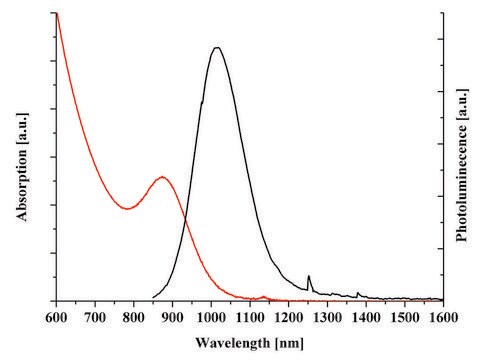900738
PbS core-type quantum dots
fluorescence λem 1400 nm, 10 mg/mL in toluene
Synonym(s):
Fluorescent nanocrystals, Lead sulfide, PbS QDs
About This Item
Recommended Products
form
liquid
Quality Level
concentration
10 mg/mL in toluene
fluorescence
λem 1400 nm
storage temp.
2-8°C
InChI
1S/Pb.H2S/h;1H2
InChI key
MIXDRAMRMDOQJH-UHFFFAOYSA-N
Looking for similar products? Visit Product Comparison Guide
Application
Signal Word
Danger
Hazard Statements
Precautionary Statements
Hazard Classifications
Aquatic Chronic 2 - Asp. Tox. 1 - Flam. Liq. 2 - Repr. 1A - Skin Irrit. 2 - STOT RE 2 - STOT RE 2 Inhalation - STOT SE 3
Target Organs
Central nervous system
Storage Class Code
3 - Flammable liquids
WGK
WGK 3
Flash Point(F)
46.4 °F - closed cup
Flash Point(C)
8 °C - closed cup
Choose from one of the most recent versions:
Certificates of Analysis (COA)
Don't see the Right Version?
If you require a particular version, you can look up a specific certificate by the Lot or Batch number.
Already Own This Product?
Find documentation for the products that you have recently purchased in the Document Library.
Articles
In this article, the properties of some of the new non-cadmium based QDs along with different applications of QDs are summarized.
Dr. Delehanty and researcher introduce recent advances in the use of cadmium-free quantum dots for bioimaging. Focus is placed on strategies that have emerged in the last five years for design, synthesis, and surface modifications of non-Cd quantum dots (QDs) for bioimaging and sensing applications.
Our team of scientists has experience in all areas of research including Life Science, Material Science, Chemical Synthesis, Chromatography, Analytical and many others.
Contact Technical Service










